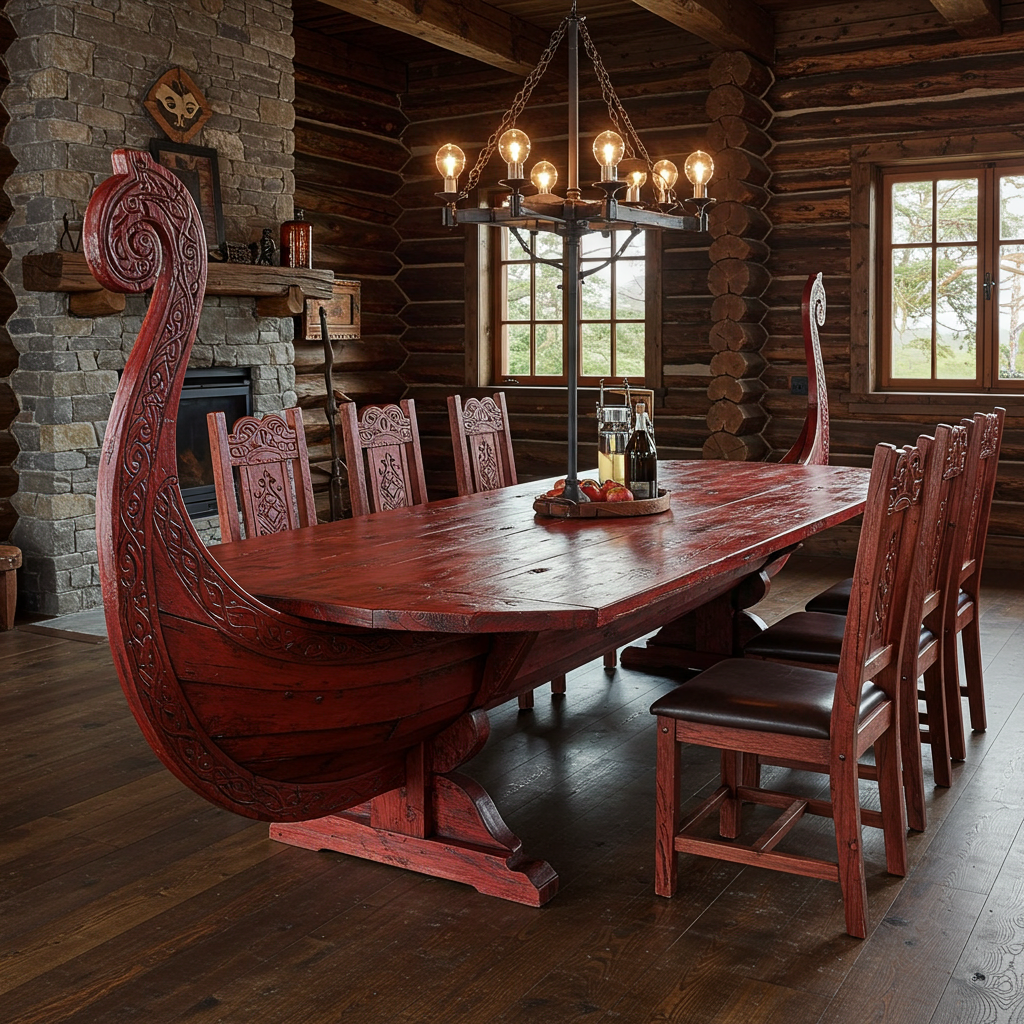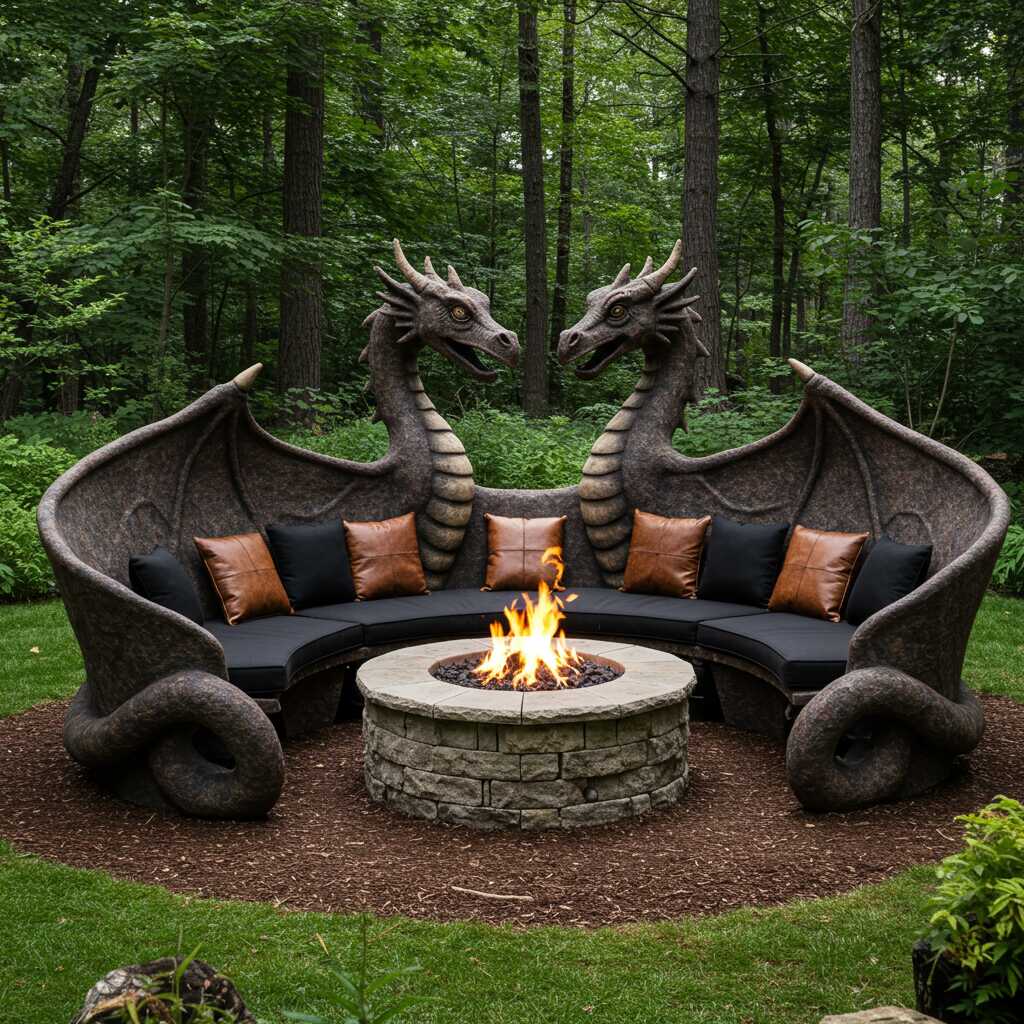The dining table is more than just a piece of furniture; it is a gathering point, a space where stories are shared, bonds are forged, and memories are made. Among the myriad designs that have graced homes throughout history, few evoke as much intrigue and admiration as the Viking ship shaped dining table. Inspired by the iconic longships of the Norse seafarers, these tables embody a fascinating blend of functionality and artistry, capturing the essence of an era defined by exploration, craftsmanship, and communal living.
The phrase “From Sea to Feast” encapsulates the transformation of the Viking longship—a vessel of conquest and discovery—into a symbol of unity and hospitality. These tables are not mere replicas but reinterpretations of a cultural legacy, bringing the spirit of the Vikings into modern spaces. In this article, we delve into the allure of Viking ship-shaped dining tables, exploring their historical roots, design intricacies, and the profound symbolism they carry. By understanding their significance, we can appreciate how these unique creations bridge the past and present, turning every meal into a celebration of heritage.
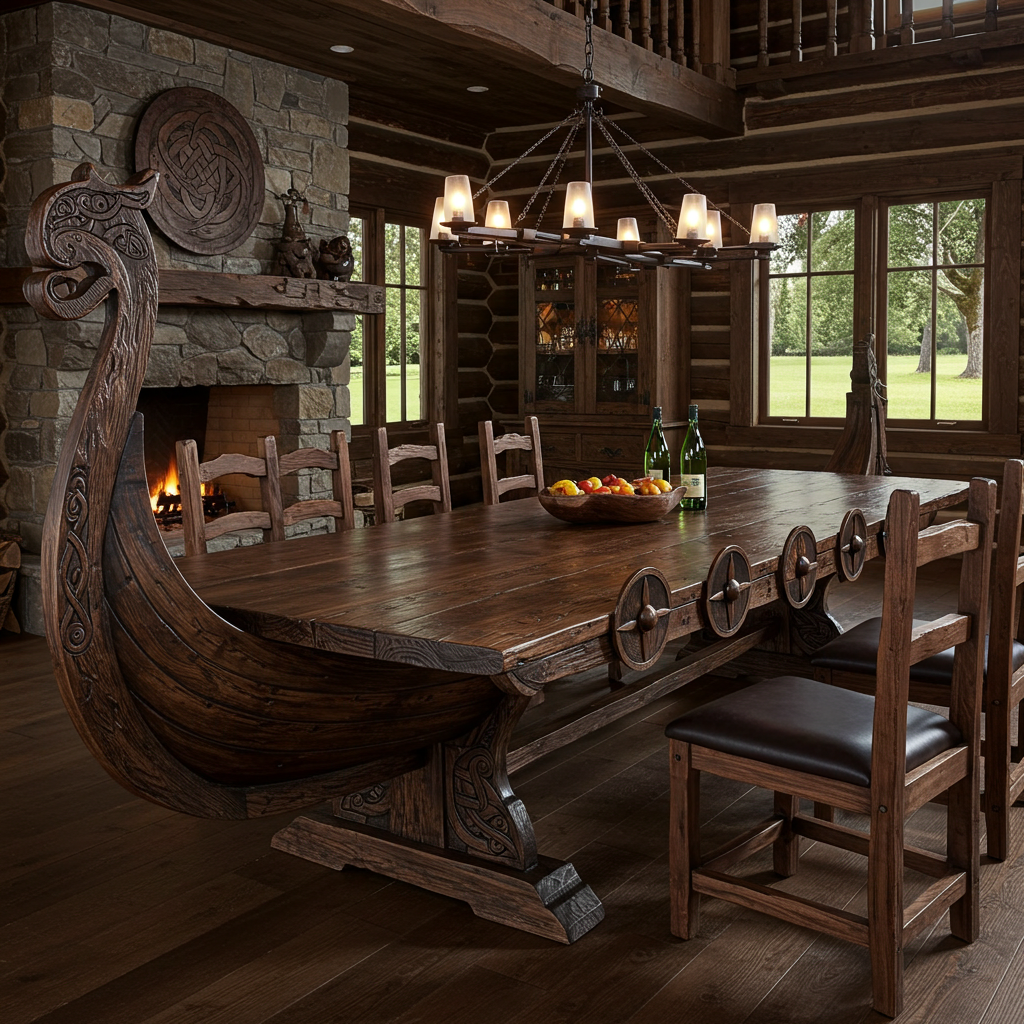
Part 1: The Historical Roots of Viking Longships
The Legacy of Viking Seafaring
To fully grasp the appeal of Viking ship-shaped dining tables, one must first understand the importance of longships in Norse culture. These sleek, wooden vessels were marvels of engineering during the Viking Age (approximately 793–1066 AD). Designed for both speed and versatility, longships allowed Vikings to navigate vast oceans, shallow rivers, and coastal waters with remarkable ease. They were instrumental in raids, trade expeditions, and exploration missions, enabling the Norse people to leave an indelible mark on Europe and beyond.
Longships were more than functional tools; they were sacred objects imbued with cultural and spiritual significance. Each ship was meticulously crafted, often adorned with intricate carvings of serpents, dragons, or other mythical creatures believed to protect sailors from harm. The construction process itself was steeped in tradition, with rituals performed to honor the gods and ensure safe voyages. For the Vikings, longships symbolized freedom, adventure, and the relentless pursuit of new horizons.
Transitioning from Sea to Land
As the Viking Age waned and societies evolved, the influence of longships endured in art, architecture, and design. Their streamlined forms and symbolic motifs inspired generations of craftsmen, who sought to preserve the essence of Norse ingenuity. Over time, elements of longship design began appearing in domestic settings, including furniture. The Viking ship-shaped dining table emerged as a testament to this enduring legacy, reimagining the grandeur of seafaring vessels for everyday life.
These tables pay homage to the structural elegance of longships, featuring elongated shapes, curved edges, and decorative accents reminiscent of prow carvings. More than just aesthetic choices, these design elements reflect the values of strength, resilience, and unity that defined Viking society. By incorporating such details into dining furniture, artisans create pieces that resonate deeply with those who appreciate history and craftsmanship.
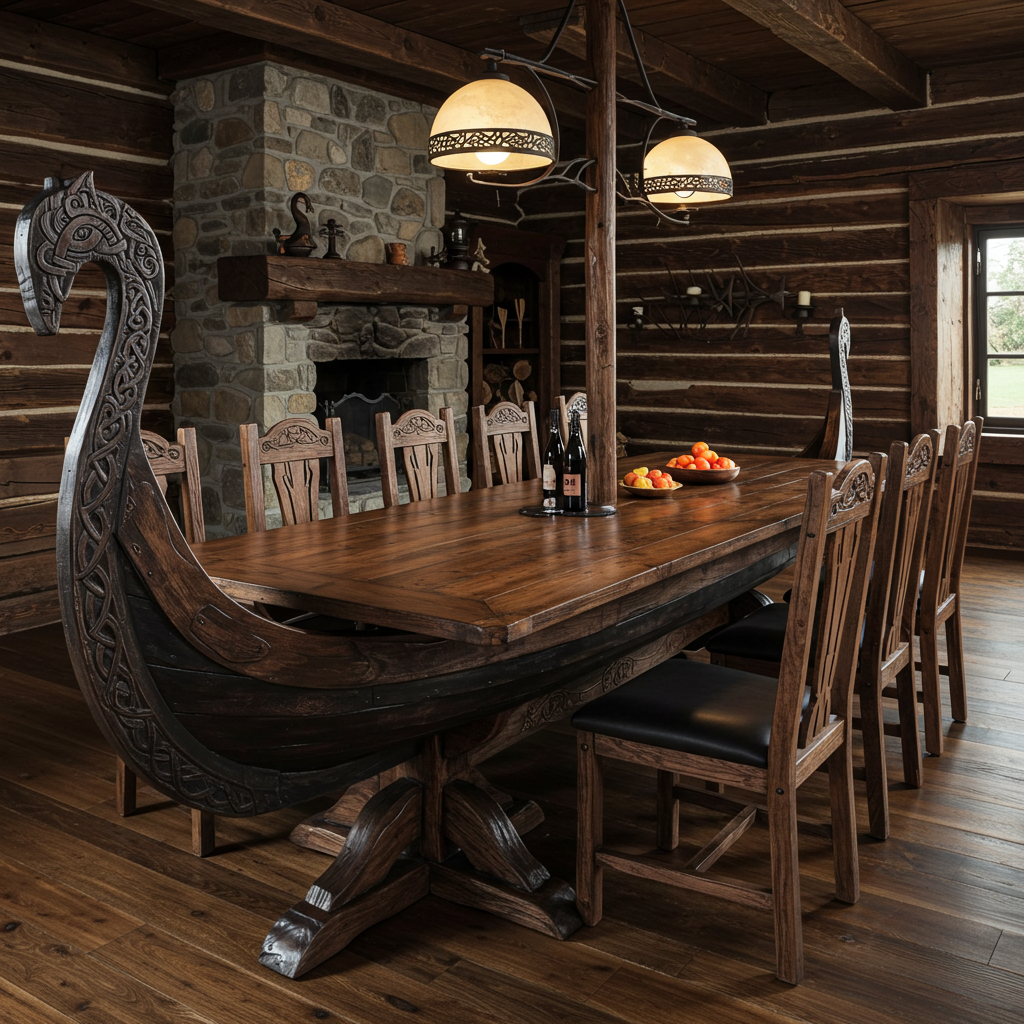
Part 2: The Artistry and Symbolism of Viking Ship-Shaped Dining Tables
Design Elements That Capture the Spirit of the Seas
A Viking ship-shaped dining table is a masterclass in design, seamlessly blending form and function. At its core, the table mirrors the silhouette of a longship, with a central axis representing the keel and outward curves evoking the graceful lines of a hull. Some designs feature carved prows at either end, echoing the dramatic figureheads of ancient vessels. Others incorporate subtle nods to maritime themes, such as rope-like borders or wave-inspired patterns etched into the wood.
Materials play a crucial role in bringing these tables to life. Craftsmen often use high-quality hardwoods like oak, walnut, or mahogany, chosen for their durability and natural beauty. These woods echo the sturdy timbers used in traditional shipbuilding, reinforcing the connection to Viking heritage. Finishes range from polished surfaces that highlight the grain to distressed textures that evoke the weathered appearance of ships battered by storms.
Lighting and placement further enhance the visual impact of these tables. Positioned beneath a chandelier or against a backdrop of nautical decor, a Viking ship-shaped dining table becomes the centerpiece of any room, drawing attention and sparking conversation. Its unique shape encourages guests to gather closely, fostering an intimate atmosphere reminiscent of feasts held in Viking halls centuries ago.
Symbolism Embedded in Every Detail
Beyond their striking appearance, Viking ship-shaped dining tables carry layers of symbolism that enrich their meaning. The longship’s association with exploration and discovery translates into a metaphor for personal growth and intellectual curiosity. Just as Vikings ventured into uncharted waters, individuals seated around such a table might embark on journeys of thought, sharing ideas and perspectives that broaden their horizons.
The communal nature of the table also reflects the importance of kinship in Viking culture. Meals were not merely occasions for sustenance but opportunities to strengthen familial ties and forge alliances. A Viking ship-shaped dining table invites diners to embrace this tradition, creating a space where laughter, storytelling, and camaraderie flourish.
Moreover, the table serves as a reminder of humanity’s relationship with the natural world. The materials used in its construction, the motifs inspired by the sea, and the craftsmanship required to bring it to life all underscore our dependence on—and reverence for—nature. In today’s fast-paced, technology-driven world, these tables offer a grounding presence, encouraging us to slow down and appreciate the simple joys of shared experiences.
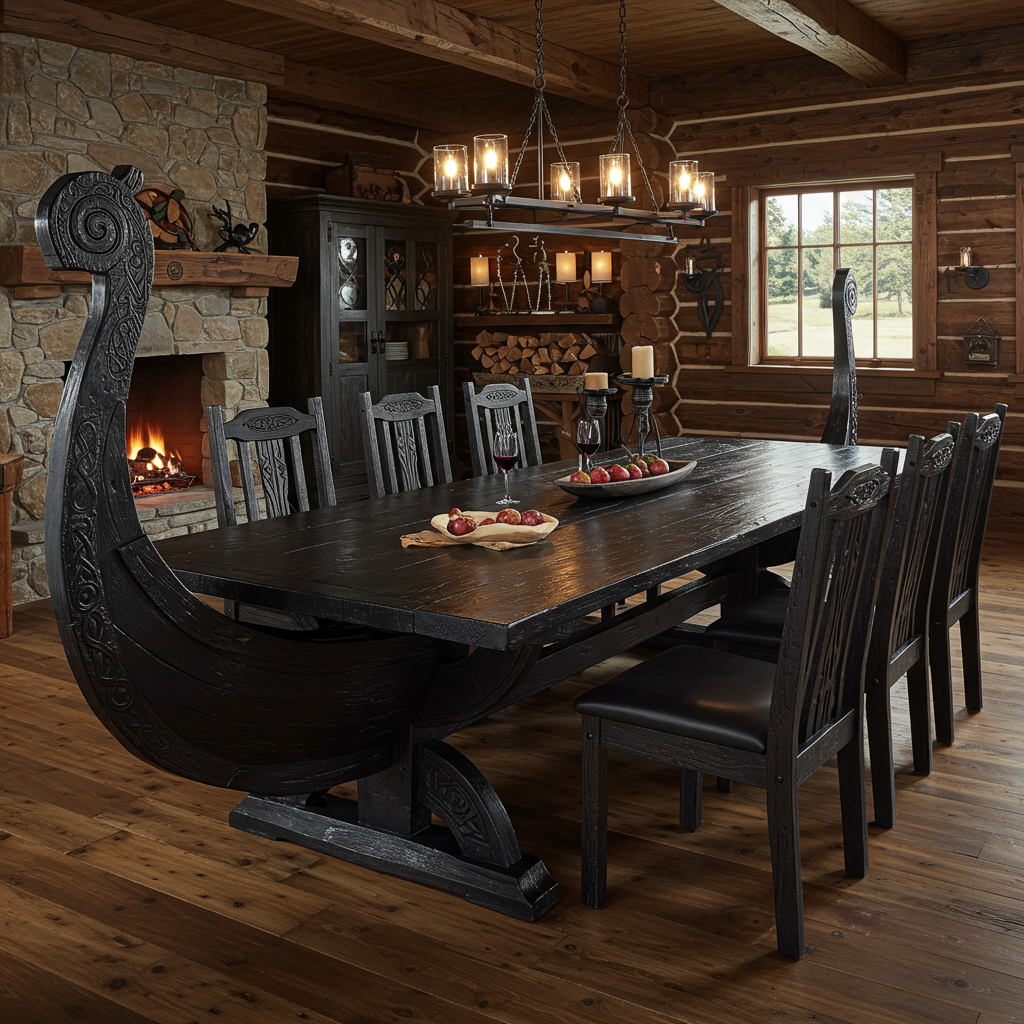
Part 3: The Modern Relevance of Viking-Inspired Design
Bridging Past and Present
While rooted in history, Viking ship-shaped dining tables hold undeniable relevance in contemporary settings. Their timeless appeal lies in their ability to adapt to diverse interior styles, from rustic farmhouse kitchens to sleek urban lofts. Whether paired with minimalist chairs or upholstered benches, these tables add a touch of drama and sophistication to any space.
In an age where mass production dominates the furniture industry, handcrafted pieces like Viking ship-shaped dining tables stand out as testaments to individuality and authenticity. Each table tells a story through its imperfections, grain patterns, and artisanal details. This emphasis on craftsmanship resonates with those who value quality over quantity and seek meaningful connections with the objects they surround themselves with.
Furthermore, these tables align with growing trends toward sustainability and eco-conscious design. By utilizing responsibly sourced materials and employing traditional techniques, artisans minimize environmental impact while honoring age-old practices. This harmonious blend of innovation and tradition ensures that Viking-inspired furniture remains relevant for generations to come.
Fostering Connection in a Digital Age
One cannot overlook the social implications of a Viking ship-shaped dining table in today’s digital-centric world. As screens increasingly dominate our interactions, there is a renewed appreciation for face-to-face communication and shared experiences. These tables provide a focal point for reconnecting with loved ones, free from distractions and immersed in the moment.
Hosting gatherings around such a table transforms ordinary meals into extraordinary events. Imagine candlelit dinners where tales of distant lands are exchanged, or holiday feasts where laughter echoes off the walls. The table’s evocative design sparks imagination, inviting participants to channel the adventurous spirit of the Vikings and embrace the joy of togetherness.
Even in solitary moments, a Viking ship-shaped dining table offers solace and inspiration. Whether enjoying a quiet breakfast or working on creative projects, its presence serves as a constant reminder of resilience, exploration, and the boundless possibilities of human endeavor.
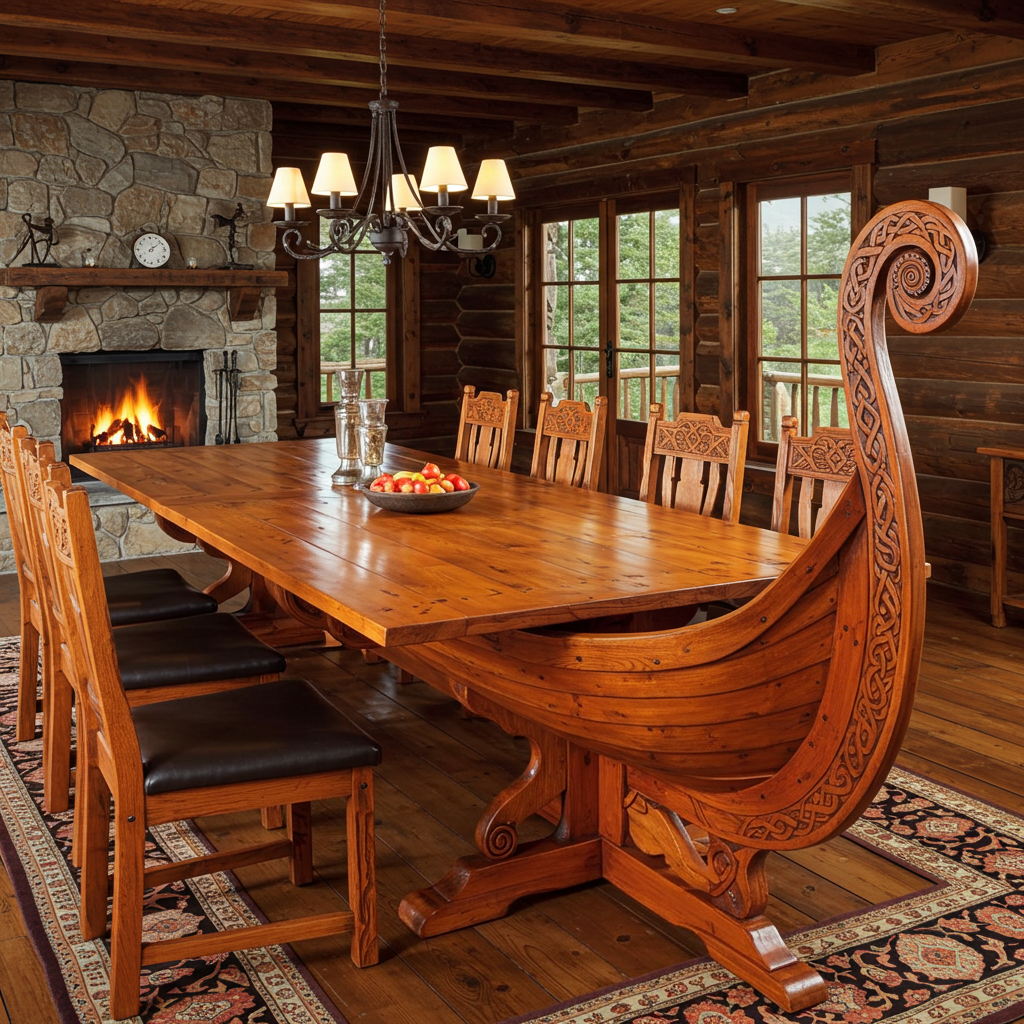
Part 4: Cultural Resonance and Philosophical Depth
A Reflection of Shared Human Values
The Viking ship-shaped dining table transcends its physical form to become a vessel for shared human values—values that have endured across centuries and cultures. At its heart, this design embodies principles such as exploration, unity, and resilience, which resonate universally regardless of time or place. These ideals are woven into the very fabric of the table, making it not just a functional object but also a philosophical statement about what it means to live fully and meaningfully.
Exploration, both literal and metaphorical, lies at the core of the Viking ethos. For the Norse seafarers, venturing into uncharted waters was not merely about conquest; it was a pursuit of knowledge, discovery, and self-realization. Similarly, the act of gathering around a Viking-inspired table invites participants to embark on intellectual and emotional journeys. Conversations flow like currents, ideas take shape like waves, and perspectives broaden as people exchange thoughts and experiences. In this way, the table becomes a microcosm of the world itself—a space where boundaries dissolve, and understanding deepens.
Unity, another cornerstone of Viking society, finds expression in the communal nature of these tables. Historically, longships were designed to carry entire crews, fostering cooperation and trust among sailors. Likewise, a Viking ship-shaped dining table encourages collective engagement, whether through family meals, festive celebrations, or casual get-togethers. Its elongated structure naturally draws people closer, creating an environment conducive to connection and collaboration.
Resilience, too, is embedded in the DNA of these designs. Longships were built to withstand harsh conditions, from stormy seas to treacherous coastlines. Their robust construction symbolized the strength and determination of those who sailed them. Translating this spirit into furniture, Viking ship-shaped dining tables exude durability and steadfastness, qualities that inspire confidence and stability in everyday life.
The Intersection of Mythology and Modernity
One cannot discuss the allure of Viking ship-shaped dining tables without acknowledging the profound influence of Norse mythology. To the Vikings, ships were more than vessels; they were sacred entities imbued with divine power. Legends abound of gods like Thor and Freyja traveling aboard magical ships, while tales of Valhalla describe fallen warriors being ferried to eternal glory in grand vessels. These mythological associations elevate the table beyond mere craftsmanship, infusing it with layers of spiritual and symbolic significance.
Incorporating elements of Norse mythology into contemporary design allows us to tap into timeless archetypes that continue to captivate the human psyche. Dragons, serpents, runes, and other motifs commonly associated with Viking culture evoke themes of protection, wisdom, and destiny. When integrated into the design of a dining table, these symbols transform the piece into a storytelling device, inviting viewers to ponder the mysteries of existence and our place within the cosmos.
At the same time, the fusion of ancient mythology with modern aesthetics speaks to the adaptability of cultural traditions. While rooted in history, Viking ship-shaped dining tables are reinterpreted for today’s sensibilities, proving that heritage need not be static. Instead, it can evolve alongside society, remaining relevant and inspiring new generations. This dynamic interplay between past and present underscores the enduring appeal of these tables, positioning them as bridges between eras and ideologies.
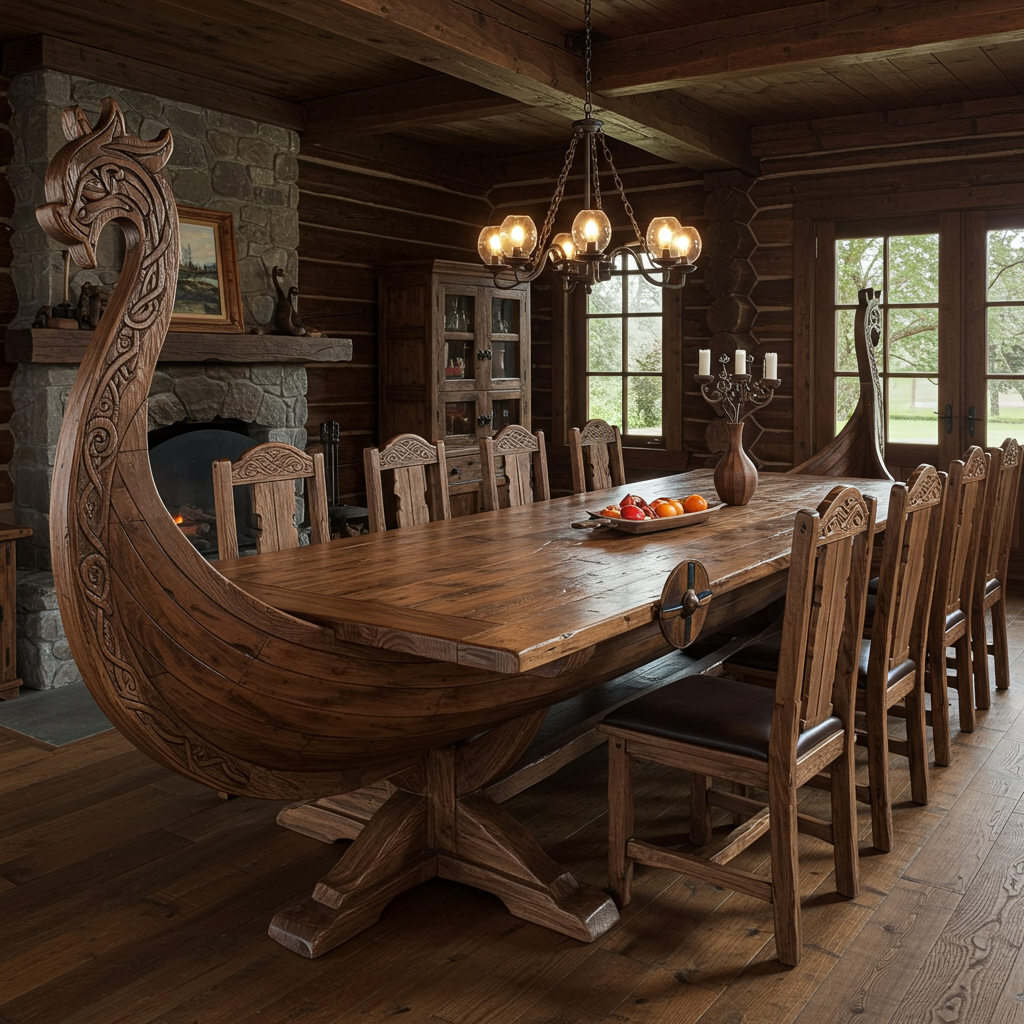
Conclusion: A Timeless Tribute to Heritage and Hospitality
The Viking ship-shaped dining table is far more than a piece of furniture; it is a celebration of history, artistry, and human connection. From its origins in the rugged seas of the Viking Age to its place in modern homes, this remarkable design captures the imagination and stirs the soul. It invites us to reflect on our shared past while embracing the promise of the future.
By honoring the legacy of Viking longships, these tables remind us of the power of innovation, the importance of community, and the enduring allure of the unknown. They challenge us to think beyond the confines of our daily routines and aspire to greater heights—much like the intrepid explorers who once sailed across uncharted waters.
Ultimately, a Viking ship-shaped dining table transforms a simple act of eating into a profound experience, weaving together threads of culture, craftsmanship, and camaraderie. It stands as a testament to the timeless appeal of good design and the universal desire to create spaces where memories are made and cherished. So, the next time you gather around such a table, take a moment to appreciate the rich tapestry of stories it represents—from sea to feast and beyond.
